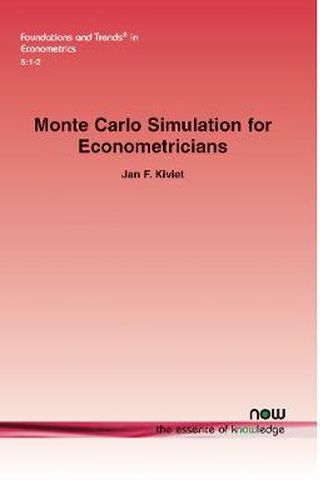Readings Newsletter
Become a Readings Member to make your shopping experience even easier.
Sign in or sign up for free!
You’re not far away from qualifying for FREE standard shipping within Australia
You’ve qualified for FREE standard shipping within Australia
The cart is loading…






This title is printed to order. This book may have been self-published. If so, we cannot guarantee the quality of the content. In the main most books will have gone through the editing process however some may not. We therefore suggest that you be aware of this before ordering this book. If in doubt check either the author or publisher’s details as we are unable to accept any returns unless they are faulty. Please contact us if you have any questions.
Monte Carlo Simulation for Econometricians presents the fundamentals of Monte Carlo simulation (MCS), pointing to opportunities not often utilized in current practice, especially with regards to designing their general setup, controlling their accuracy, recognizing their shortcomings, and presenting their results in a coherent way.
The author explores the properties of classic econometric inference techniques by simulation. The first three chapters focus on the basic tools of MCS. After treating the basic tools of MCS, Chapter 4 examines the crucial elements of analyzing the properties of asymptotic test procedures by MCS. Chapter 5 examines more general aspects of MCS, such as its history, possibilities to increase its efficiency and effectiveness, and whether synthetic random exogenous variables should be kept fixed over all the experiments or be treated as genuinely random and thus redrawn every replication. The simulation techniques that we discuss in the first five chapters are often addressed as naive or classic Monte Carlo methods.
However, simulation can also be used not just for assessing the qualities of inference techniques, but also directly for obtaining inference in practice from empirical data. Various advanced inference techniques have been developed which incorporate simulation techniques. An early example of this is Monte Carlo testing, which corresponds to the parametric bootstrap technique. Chapter 6 highlights such techniques and presents a few examples of semi-parametric bootstrap techniques. This chapter also demonstrates that the bootstrap is not an alternative to MCS but just another practical inference technique, which uses simulation to produce econometric inference. Each chapter includes exercises allowing the reader to immerse in performing and interpreting MCS studies.
The material has been used extensively in courses for undergraduate and graduate students. The various chapters all contain illustrations which throw light on what uses can be made from MCS to discover the finite sample properties of a broad range of alternative econometric methods with a focus on the rather basic models and techniques.
$9.00 standard shipping within Australia
FREE standard shipping within Australia for orders over $100.00
Express & International shipping calculated at checkout
This title is printed to order. This book may have been self-published. If so, we cannot guarantee the quality of the content. In the main most books will have gone through the editing process however some may not. We therefore suggest that you be aware of this before ordering this book. If in doubt check either the author or publisher’s details as we are unable to accept any returns unless they are faulty. Please contact us if you have any questions.
Monte Carlo Simulation for Econometricians presents the fundamentals of Monte Carlo simulation (MCS), pointing to opportunities not often utilized in current practice, especially with regards to designing their general setup, controlling their accuracy, recognizing their shortcomings, and presenting their results in a coherent way.
The author explores the properties of classic econometric inference techniques by simulation. The first three chapters focus on the basic tools of MCS. After treating the basic tools of MCS, Chapter 4 examines the crucial elements of analyzing the properties of asymptotic test procedures by MCS. Chapter 5 examines more general aspects of MCS, such as its history, possibilities to increase its efficiency and effectiveness, and whether synthetic random exogenous variables should be kept fixed over all the experiments or be treated as genuinely random and thus redrawn every replication. The simulation techniques that we discuss in the first five chapters are often addressed as naive or classic Monte Carlo methods.
However, simulation can also be used not just for assessing the qualities of inference techniques, but also directly for obtaining inference in practice from empirical data. Various advanced inference techniques have been developed which incorporate simulation techniques. An early example of this is Monte Carlo testing, which corresponds to the parametric bootstrap technique. Chapter 6 highlights such techniques and presents a few examples of semi-parametric bootstrap techniques. This chapter also demonstrates that the bootstrap is not an alternative to MCS but just another practical inference technique, which uses simulation to produce econometric inference. Each chapter includes exercises allowing the reader to immerse in performing and interpreting MCS studies.
The material has been used extensively in courses for undergraduate and graduate students. The various chapters all contain illustrations which throw light on what uses can be made from MCS to discover the finite sample properties of a broad range of alternative econometric methods with a focus on the rather basic models and techniques.